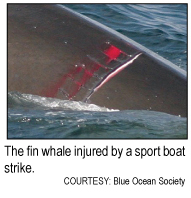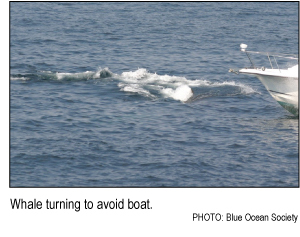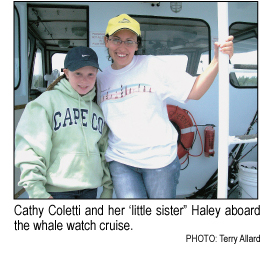|
 Ambassador for his species: Ambassador for his species:
If a whale could speak
By Cathy Coletti
[printer friendly page]
“Do you know you hit a whale?!”
shouted my mother from the side of the Atlantic Queen about 20
miles (32 kilometers) offshore in the Gulf of Maine. The upswell
of anger ran through this group of about 60 whale watchers like
electricity.
It was one of those days you
hope will never happen again. Too many circumstances had come
together, too many things that are unknowable and unplannable.
The seas were calm. The sun was out. Visibility was perfect.
The cool ocean air smelled of salt. My mother was meeting my
little sister from Big Brothers Big Sisters after about a year
of trying to get a mutually agreeable date. The three of us were
out on Jeffrey’s Ledge in the Gulf of Maine in mid July,
seeing whale after whale.
I had been afraid that we might
be disappointed and not see anything. At first my little sister,
10, and I kept imagining that we saw whales, “What’s
that?” “Over there!” but it would turn out to
be just the way the sun hit the water or a buoy. Then she pointed
to the front of the boat and yelled, “WHALE!” People
rushed forward to see as the boat came to a stop.
From above, our naturalist, Jen
Kennedy from the Blue Ocean Society for Marine Conservation,
a New Hampshire-based nonprofit, informed us it was a “minke
whale.” Our luck held with more minke whale sightings and
then a fin whale sighting, an endangered species that is nothing
to snuff at: it’s the second-largest animal on earth, second
only to the blue whale. At up to 70-feet (21-meters) long, it’s
about as big as 13 human adults laid head to feet.
 An
uncommon sighting An
uncommon sighting
Towards the end of the day on our way back to Rye Harbor, New
Hampshire, the Atlantic Queen came to a halt once again. It was
a fin whale. The spout rose above the ocean as the whale surfaced
to breathe, showing us its shiny black back. We were told that
we were only seeing a very small part of the gigantic body. What
a great ending to the day, or so we thought.
When a small sport boat came
out of the corner of my peripheral vision I thought, “Geez,
that guy is getting awfully close to that whale.” The loudspeaker
said, “This boater is not obeying whale watch regulations.
He’s way too close.” Then he went right over the place
where we had last seen the whale surface.
When the whale came up again,
bleeding slash marks were clear on the shiny black skin. There
was a silence, and then Kennedy’s voice over the loudspeaker,
“Never in my 12 years of whale watching experience have
I ever seen this happen.”
My little sister said she felt
sad. The crowd seemed shocked and then angry. As the Atlantic
Queen pulled up alongside of the sport boat to get documentation
for the authorities, my mother yelled, “Do you know you
hit a whale?” The boat’s operator didn’t respond.
Sharing the waters
What a sobering reminder that we share our ocean. As I sat with
the reporter from Fosters Daily Democrat, I told her
about how I would like to see this fin whale be an ambassador
for his species. That through press coverage and word of mouth,
the whale could simply tell us “Slow the heck down out there
and watch out, we’re here too!”
 It
was prime boating season, which also coincides with the movement
of fin, humpback, minke and other whale and dolphin species,
which come to the Gulf of Maine to feed on schooling fish and
krill. It
was prime boating season, which also coincides with the movement
of fin, humpback, minke and other whale and dolphin species,
which come to the Gulf of Maine to feed on schooling fish and
krill.
Harming an endangered species
of whale is a violation of both the Marine Mammal Protection
Act and the Endangered Species Act, with fines of up to $50,000,
along with imprisonment and seizure of the vessel.
The captain of the Atlantic Queen
and Kennedy of the Blue Ocean Society reported the incident to
the authorities, and in mid-September, National Oceanic and Atmospheric
Administration investigators found the boat driver in violation
of the Marine Mammal Protection Act. The driver was charged an
$8,500 fine, and had 30 days from the notice of the charge to
contest it, work with the attorneys to come up with a different
amount, or pay the whole fine.
The whale has not been seen since
the strike. Right now no one can be sure of its condition, but
Blue Ocean does sometimes observe whales with scars.
Updates on the case and news
on the whale’s condition can be found at the Blue Ocean Society.
Cathy Coletti is assistant
editor of the Gulf of Maine Times.
|
Spotlight
on fin whales
Fin whales
are the second-largest species ever to live on the Earth. They
are 60 feet to 70 feet (18 meters to 21 meters) long on average.
The largest one measured was a female that was longer than 80
feet or 24 meters. They weigh 40 tons to 50 tons (about the weight
of 12 elephants put together). Although they are an endangered
species, Blue Ocean Society in Portsmouth, New Hampshire, sees
them on about 80 percent of its whale watch trips.
SOURCE:
Blue Ocean Society
|
|
![]()
